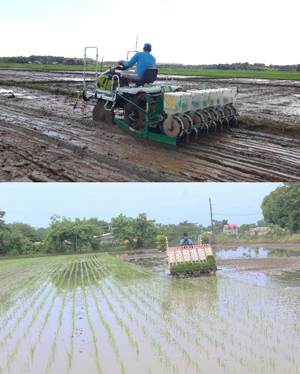 Mechanizing farm operations is the best way to solve the lack of skilled farm workers during the peak of transplanting and harvesting season.
Mechanizing farm operations is the best way to solve the lack of skilled farm workers during the peak of transplanting and harvesting season.
In Region 2, mechanized rice farming resulted in lower production cost due to savings in labor. This was reported by Engr. Generoso M. Oli, Chief of the Field Operations Division of the Department of Agriculture- Regional Field Office 02 (DA-RFO-2) Tuguegarao City, Cagayan.
The project led by Engr. Oli is one of the entries at the upcoming National Symposium on Agriculture Aquatic and Natural Resources Research and Development (NSAARRD) organized by the Philippine Council for Agriculture, Aquatic, and Natural Resources Research and Development of the Department of Science and Technology (DOST-PCAARRD), recently held at PCAARRD, Los Baños, Laguna.
It showcased and promoted mechanized seeds and seedling preparation, crop establishment, and harvesting to farmers’ organization. The technologies reduced production cost and man-day labor requirement. It addressed the problem of labor scarcity in the region during peak season.
In a report presented to PCAARRD, Engr. Oli and his team introduced rice production using mechanized crop establishment machinery such as mechanical transplanter and direct seeder suitable for medium-elevated irrigated conditions in Region 02.
They set-up five demonstration sites in 2017 during the wet season. These are located in Fugu, Ballestero, Cagayan; Baculud, Amulung, Cagayan; Nuesa, Roxas, Isabela; La Paz, Cabanatuan, Isabela; and Dadap, Solano, Nueva Vizcaya.
For each of the five sites, three demonstration plots, each with an area of 0.5 hectare were allocated for the use of mechanical direct seeder, mechanical transplanter, and conventional method of crop establishment.
Results were positive. Compared with the conventional manual transplanting, the labor requirement in all five project sites reduced by 80-84 percent using mechanical direct seeder and 40-50 percent using mechanical transplanter.
Farm Workers needed for crop establishment using mechanical direct seeder were 5 and 15 workers for mechanical transplanter, at 8 hours of work per day. These values were lower compared with conventional farming’s labor requirement of 26-32 persons.
The project attained the recommended plant population for both direct mechanical seeder and transplanter because of the precise distance of plants between rows and hills.
Moreover, Engr. Oli reports that the use of mechanical direct seeder resulted in rice yields ranging from 5.18 to 7.97 tons per hectare (t/ha). Three of the five demo sites gave yields higher than the conventional farming.
On the other hand, the use of mechanical transplanter resulted in rice yields ranging from 5.99 to 8.20 t/ha due to higher plant population, productive tillers, and filled grains. Four demo sites gave values that are a bit higher or comparable with the yields from conventional farming.
With mechanical direct seeder, the lowest total production cost was recorded in Solano, Nueva Vizcaya at 32,880 pesos per hectare. Net income was highest in Nuesa, Roxas, Isabela at 101,025 pesos per hectare and highest returns on investment of 238 percent.
With mechanical transplanter, the lowest total production cost per hectare of 41,288 pesos was recorded in Solano, Nueva Vizcaya, also with the highest net income of 103,892 pesos and highest returns on investment of 249 percent.
During the technology demonstration and promotion, 245 individuals had been capacitated on the preparation of seeds, soil media, and seedling trays. Three hundred thirty-seven farmers participated in field days during crop establishment using mechanical direct seeder; 255 during mechanical transplanting; and 276 during harvesting.
To expand the benefits to other farmers, Engr. Oli recommended further technology demonstrations in Rice Model Farm Cluster Areas per municipality and putting-up Farm Service Providers who will rent out machinery and other custom services to farmers in the locality.
